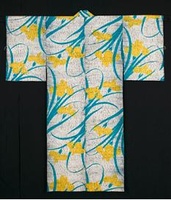TOUR OF THE JAPANESE KIMONO, 1915-1940: FROM TRADITION TO READY-TO-WEAR EXHIBIT AT THE ART INSTITUTE OF CHICAGO
| Sep 201115 | ||
| 5:30p.m. | ||
The Art Institute of Chicago
111 S Michigan Ave
Chicago, Illinois
United States

Tour of the Japanese Kimono, 1915-1940: From Tradition to Ready-to-Wear exhibit at the Art Institute of Chicago
*Meet in front of the Art Institute of Chicago museum shop promptly at 5:30 p.m. Please note that unfortunately we will not be able to wait for late comers.
$22 JASC Members/$25 Non-Members
(20 Maximum)
Tickets will be passed out the day of the event
Come join us for a tour of the Japanese Kimono, 1915-1940: From Tradition to Ready-to-Wear exhibit at the Art Institute of Chicago, lead by Odile Joassin, Assistant Curator, The Department of Textiles, Art Institute of Chicago. Learn more about the history of kimono, as well as behind-the-scenes information on the creation of the exhibit.
The designs of kimono for formal and ceremonial events often adhered to conventional patterns with carefully planned designs suited to specific occasions. They were expensive undertakings, often custom-made and purchased from merchants who specialized in kimonos. With noticeably shorter sleeves, informal kimono and haori for everyday use were less opulent than their formal counterparts. The design of this more casual wear borrowed from the large repertoire of traditional motifs but also included abstracted forms and designs inspired by Western art movements.
In the 1910s, informal kimonos took a new turn with ready-to-wear designs appearing in department stores, where a quality garment could be bought at an affordable price, and by the mid-1920s, these broadly available styles were changing seasonally akin to Western fashion. Often referred to as taishô modo (referring to Taishô fashionable kimono) or taishô roman (Taishô romantic style), these desirable and fashionable garments maintained a conventional form while displaying bold and brightly colored designs and ornamentation. They appealed to the urban modern girl who embraced popular culture and changing fashions.
Although the basic construction and form of the kimono has altered little over the course of six centuries, the evolving patterning and decoration make the kimono an exquisite and dynamic garment. By showcasing the kimono’s influences and developments from formal traditions to graphically vibrant off-the-rack designs, this exhibition illustrates how the Japanese have embraced modernism while still retaining their cultural history.
 intrepidmouse
.
Last modified Sep 05, 2011 11:19 a.m.
intrepidmouse
.
Last modified Sep 05, 2011 11:19 a.m.

 Journal feed
Journal feed


Exhibition